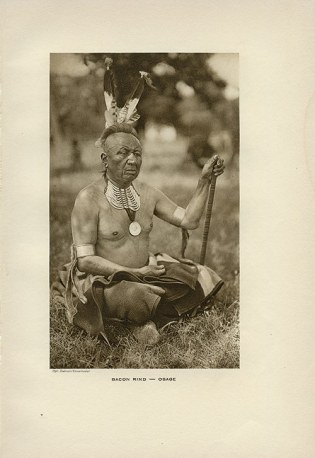

Press Photo by Wide World Photos, 1924
Caption reads: Mother clings to Indian Custom, but Daughter … much American: The wife and daughter of Red Eagle, Principal Chief of the Osage Tribe, in Washington to adjust some finances with the Interior Department. The daughter, Mary, prefers the American fashion while mother clings faithfully to the Osage tribal robes.
Possibly Chief Red Eagle is Paul Red Eagle who was Chief from 1923-24, following Chief Ne-Kah-Wah-She-Tun-Kah’ who died while in office.
Since the 1890s the Osage tribe had had substantial income derived from the sale of drilling rights to oil discovered on their lands. “With extraordinary foresight, the tribe had reserved subsurface mineral rights even though the land had been allocated among the 2,229 enrolled Osages.” (page 280, Damming the Osage).
Money generated by the sales of drilling rights made enrolled Osages “probably the wealthiest people on earth” (New York Times November 18, 1898). Having had great wealth and the advantages of wealth – many Osages traveled the world and pursued higher education, modern houses, fashion, and automobiles; others maintained their Osage cultural lifestyle, language and traditions. One who maintained the cultural lifestyle was Paul Red Eagle.
Six years after this photo was taken, Chief Red Eagle died. John Joseph Mathews, author of many books and articles on the Osages, attended his funeral and wrote a moving and graphic account of the final rites for the venerable warrior/chief. In “Passing of Red Eagle” (Sooner Magazine, Feb. 1930), Mathews remembers:
For ninety years Red Eagle had lived among his people. For that many years of constant changes, contacts and shifting scenes, he remained an Indian; thinking Indian thoughts and dreaming his own dreams. In his later years he seemed to be waiting for something. He lived quietly on this ranch preferring his horse to a car until his eightieth year. He had oil royalties but desired to live in simplicity. He had seen many things and had taken part in the wars in the southern part of the state; he talked of these wars with members of the tribe. He saw brick buildings rise up among the jack-oaks and his nation spanned with roads, some of them sinuous black ribbons winding over sandstone ridges and limestone prairie. He watched with passivity, shiny oil derricks spring up like phantasmal fungi from valleys, wooded hills and prairie. Yet, with him remained the spirit of his fathers. To the end he remained an Indian. Frenzied wealth seeking and confused material progress did not disturb the soul of Red Eagle.
A Catholic priest presided at the funeral, but after the sermon and prayers, the son of Red Eagle and his wife came forward “and began the heart tearing wail of the race. No suffering European could so touch the deepest chords of one’s heart as does the long, quavering cry of a mourning Osage.”
 When we published this photograph of Osage Chief Red Eagle’s Wife and Daughter we speculated that the Chief referred to was Paul Red Eagle. Recently Michael Snyder, author of a soon-to-be-released biography of John Joseph Mathews set us straight.
When we published this photograph of Osage Chief Red Eagle’s Wife and Daughter we speculated that the Chief referred to was Paul Red Eagle. Recently Michael Snyder, author of a soon-to-be-released biography of John Joseph Mathews set us straight.


